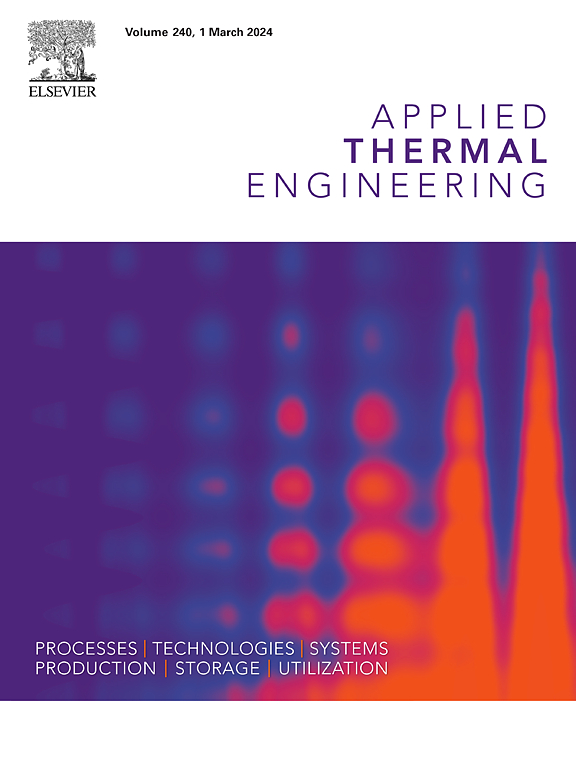不同被动中断几何技术实现新型参数评价对提高三维管道热工性能的影响
IF 6.1
2区 工程技术
Q2 ENERGY & FUELS
引用次数: 0
摘要
本文研究了采用被动几何修饰的管道的流体动力和热性能,重点是优化流体流动动力学和传热效率。计算分析评估了恒定热流条件下三维管道几何形状的湍流行为和热交换,雷诺数从1000到14000。该研究采用单相水基热流体动力学框架来评估插入扭曲带(ITT)、波纹环直径(CRD)和凹陷表面直径(DSD)管道配置。结果表明,Nu的数值模拟与经验方程的最大差异为7.9%。同样,两种方法之间的摩擦系数(f)的最大差异为6.5%。此外,与光滑管道相比,采用不同的被动几何设计显著提高了努塞尔数(Nu)和整体热性能。结构的改变会引起二次涡旋流动并放大湍流,破坏热边界层并改善传热。超过统一的性能评价标准证实了这些几何形状优于传统的光滑通道。除了提高传热率外,该研究还强调了被动式几何结构对压降和能耗的影响。虽然酒窝和波纹设计表现出优越的传热能力,但由于表面粗糙度和流体相互作用的增加,它们也会产生更高的压降。然而,大量的热性能改进通常补偿额外的泵送功率所需。基于评估几何形状的总体热性能因子(PEF)的比较性能分析表明,凹窝表面设计(DSD)的PEF值最高,约为1.8。其次是波纹管(CRD)和扭管(ITT)构型,PEF值分别为1.77和1.61。该研究得出结论,选择最合适的配置取决于热增强和能量消耗之间的理想平衡,在优先传热的情况下,酒窝设计是最有效的。本文章由计算机程序翻译,如有差异,请以英文原文为准。
Effect of varying passive interrupted geometrical techniques to implement novel parametric assessment of improving thermal-hydraulic performance in 3D pipe
This study investigates the hydrodynamic and thermal performance of pipes incorporating passive geometric modifications, focusing on optimizing fluid flow dynamics and heat transfer efficiency. A computational analysis evaluates turbulent flow behavior and heat exchange in three-dimensional pipe geometries under constant heat flux conditions, spanning Reynolds numbers from 1000 to 14,000. The research employs a single-phase, water-based thermo-hydrodynamic framework to assess Insert Twisted Tape (ITT), Corrugated Ring Diameter (CRD), and Dimple Surface Diameter (DSD) pipe configurations. Results indicate that the maximum difference between the numerical simulations and the empirical equations for Nu is 7.9%. Similarly, the maximum difference in the friction factor (f) between the two approaches is 6.5 %. Also, using different passive geometric designs significantly enhance the Nusselt number (Nu) and overall thermal performance compared to smooth pipes. Structural modifications induce secondary vortical flows and amplify turbulence, disrupting thermal boundary layers and improving heat transfer. Performance evaluation criteria exceeding unity confirm the superiority of these geometries over conventional smooth channels. In addition to enhancing heat transfer rates, the study highlights the impact of passive geometric configurations on pressure drop and energy consumption. While dimpled and corrugated designs exhibit superior heat transfer capabilities, they also generate higher pressure drops due to increased surface roughness and fluid interaction. However, the substantial thermal performance improvement often compensates for the additional pumping power required. A comparative performance analysis based on the overall thermal performance factor (PEF) of the evaluated geometries indicates that the dimpled surface design (DSD) achieved the highest PEF value of approximately 1.8. The corrugated (CRD) and twisted tube (ITT) configurations followed, with PEF values of 1.77 and 1.61, respectively. The study concludes that selecting the most suitable configuration depends on the desired balance between thermal enhancement and energy expenditure, with dimpled designs being the most effective in scenarios prioritizing heat transfer.
求助全文
通过发布文献求助,成功后即可免费获取论文全文。
去求助
来源期刊

Applied Thermal Engineering
工程技术-工程:机械
CiteScore
11.30
自引率
15.60%
发文量
1474
审稿时长
57 days
期刊介绍:
Applied Thermal Engineering disseminates novel research related to the design, development and demonstration of components, devices, equipment, technologies and systems involving thermal processes for the production, storage, utilization and conservation of energy, with a focus on engineering application.
The journal publishes high-quality and high-impact Original Research Articles, Review Articles, Short Communications and Letters to the Editor on cutting-edge innovations in research, and recent advances or issues of interest to the thermal engineering community.
 求助内容:
求助内容: 应助结果提醒方式:
应助结果提醒方式:


